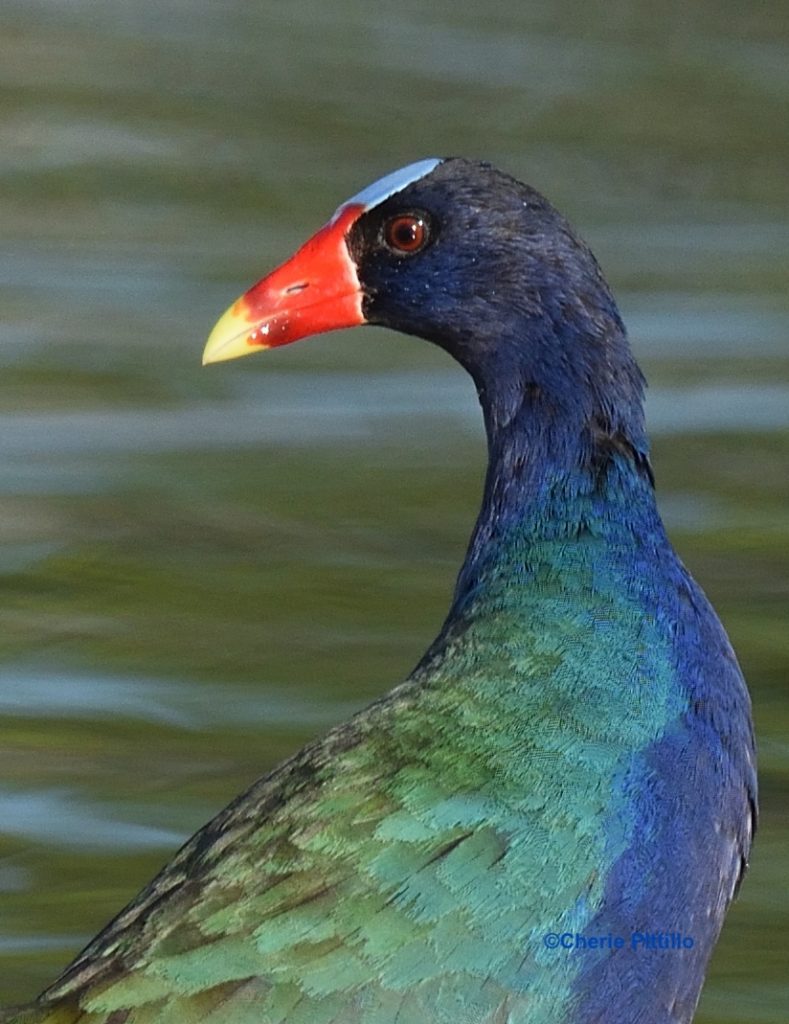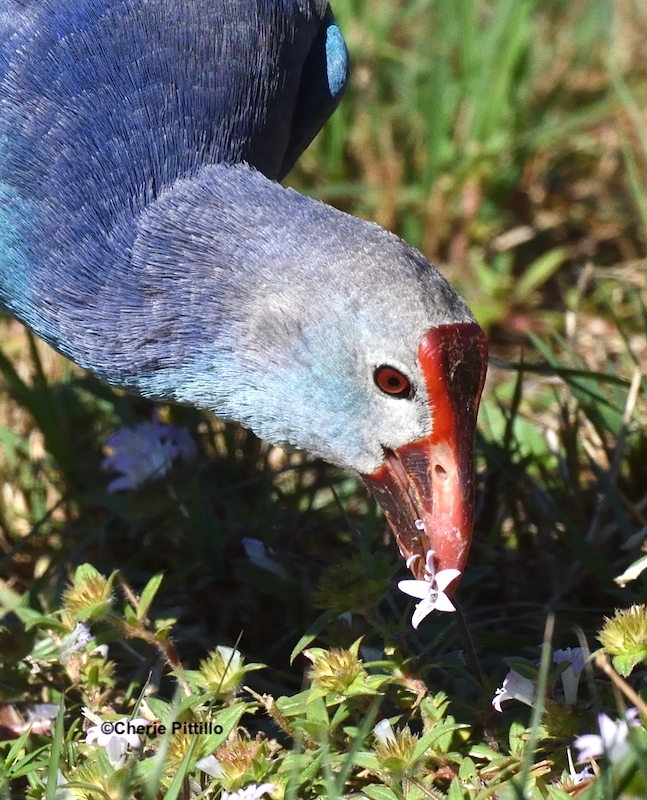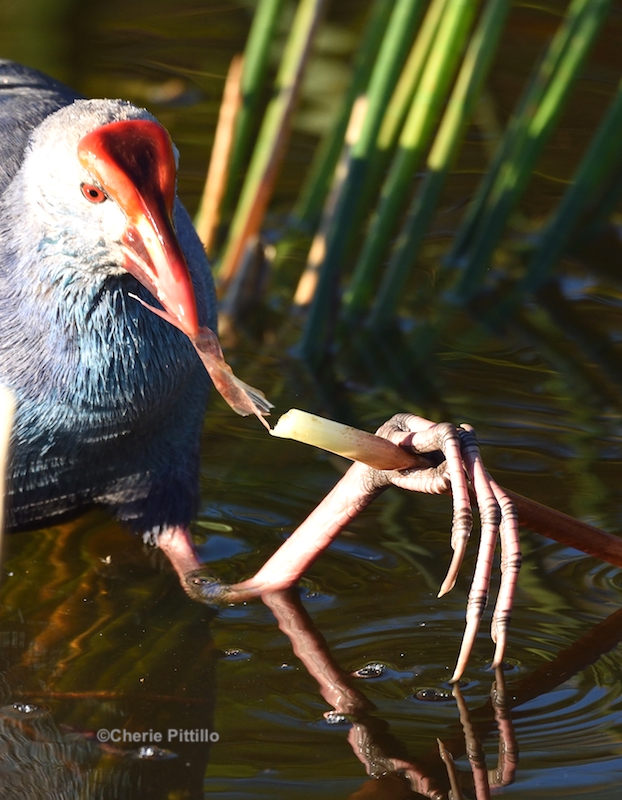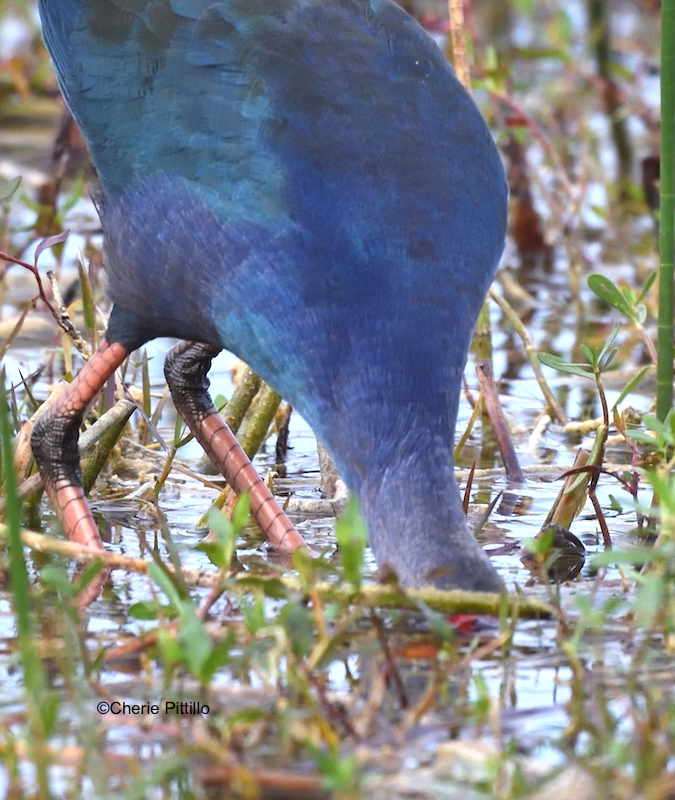Thirty-four chicken-sized birds emerge from cattails to engage in a dodge-ball dance in an open, flat wetland of southern Florida. Usually the Gray-headed Swamphen in Florida forms groups of two or up to 18 birds which can include prior offspring. Their “dancing” or charging at each other are actually territorial disputes.

Swamphens chasing
Eager bird watchers often mistake the Gray-headed Swamphen, formerly called the Purple Swamphen, for the Purple Gallinule, since both sport similar blue/green body feathers. How confusing is that? Plus how often would you expect to see two colorful wetland species in the same habitat?

Gray-headed Swamphen from a distance

Purple Gallinule sports similar colors to the Gray-headed Swamphen

Colorful feathers of the Gray-necked Swamphen resemble those of its cousin, the Purple Gallinule
Upon closer inspection compare the yellow legs of the Purple Gallinule with those pink legs of the swamphen. Also, the gallinule has a blue frontal shield on its face and a candy corn bill. Its steroidal cousin has a red shield and bill.

Yellow legs of Purple Gallinule

Pinkish legs of Gray-headed Swamphen

Purple Gallinule with blue facial shield and yellow-tipped red bill

Red bill and red facial shield of Gray-headed Swamphen
Both are members of the rail family which includes coots, gallinules, rails, and crakes. This swamphen is the heaviest rail in North America with an 18” length, around a 3 foot wingspan and weighs about 1.5 lbs. while the gallinule weighs less than 8 ounces. In an interesting note, heads of female swamphens are usually blue while males sport gray feathers there. Some birders thought they were two different subspecies.
RANGE
However, this swamphen species isn’t a Florida native nor one of North, Central, or South America. Its native range includes the Middle East through India and Southern Asia to Thailand. Recently it has been reclassified into six species. That’s fitting because like its reclassification its range now extends into Europe, Australia, New Zealand, and Africa. And of course, Florida.
One of the reasons I wanted to share this topic is to introduce an invasive bird species and the various impacts of its range expansion in Florida as an example. Don’t let that beautiful coloration fool you. This aggressive, territorial species competes with native species for habitat and food. Eradication attempts were futile.
How did this species arrive in Florida?
References often misstate that only six or so escaped from the Miami Metro Zoo during Hurricane Andrew in 1992. In reality, two private citizens gave free range to several pairs in their residential development about 30 miles north of the zoo in the 1990s. In three years over 130 were counted there. As a non-native species it dispersed primarily to southern Florida but has been observed in Georgia.
Often considered a weak flyer because it dangles its feet during short flights, it is a STRONG flyer. This species can cover 200 miles in flight to respond to unsuitable water levels and therefore extends its range.

Actually swamphens are strong fliers but they dangle their feet on short flights
DIET
Although primarily herbivorous on aquatic or semi-aquatic plants, it is a generalist feeder and eats earthworms, mollusks, insects, lizards, rodents, small mammals, spiders, snakes, frogs and fish and their eggs, ducklings and even human food. Also it destroys agricultural crops like rice and sugar cane in Florida to yams, bananas, and other crops.

Don’t let the pretty colors fool you; the Gray-necked Swamphen competes with native species for habitat and food
I’ve seen them use their bill to pull up many aquatic plants, hold the plant in its foot, rip it apart and either take a nibble or two and drop the partially eaten plant or eat more of it. Sometimes it submerges its head to grasp the plant root or prey on a critter.

Feeding method of Gray-headed Swamphen

Gray-headed Swamphen carrying food or nest material

Swamphen searching for prey or plants
NESTING CONFLICTS
Whether the swamphen lives in a single pair or communally as in Florida, it can replace losses of the chicks up to three clutches per year. Parents do feed tender shoots but also invertebrates to their chicks. But remember this species competes with other species for nesting and tramples large areas for nests and platforms but selects only one nesting site. Also it may eat eggs and young of other birds nesting in same area.

Chick feeding on plant matter from Gray-headed Swamphen parent
HABITATS
Like its extensive menu, swamphen habitat varies to include both fresh and brackish water, marshes, lakes, ponds, rivers, shallow wetlands, golf courses, parks, stormwater treatment areas, residential areas, and some saline environments.
Although this adaptable species has not invaded the Yucatan, I wanted to illustrate how competitive and destructive an invasive, but beautiful-looking species, could be to native species. I imagine that color led the two private collectors to somehow import the probably non-regulated species into the US. And now agricultural crops, restorative wetlands, and native species suffer the consequences.

Beautiful but invasive Gray-headed Swamphen
DISCLAIMER: References do not agree or may have not updated recent information.
Sal a Pajarear Yucatán, Birds & Reserves of the Yucatan Peninsula,The Sibley Guide to Birds
https://birdsoftheworld.org/bow/species/purswa3/cur/introduction?login
https://ufdcimages.uflib.ufl.edu/IR/00/00/34/26/00001/UW31500.pdf
https://www.aba.org/birding_archive_files/birding453pranty.pdf
https://brill.com/view/journals/soan/24/6/article-p574_4.xml?language=enhttps://www.audubon.org/field-guide/bird/gray-headed-swamphen
Cherie Pittillo, “nature inspired,” photographer and author, explores nature everywhere she goes. She’s identified 56 bird species in her Merida, Yucatan backyard view. Her monthly column features anecdotes about birding in Merida, Yucatan and also wildlife beyond the Yucatan.
Contact: [email protected] All rights reserved, ©Cherie Pittillo



1 comment
Wow–I had never heard of this bird. It’s gorgeous, but not a good thing to have here at all. Thanks for the wonderful pictures and interesting text about them. I hope they don’t do well in slightly warmer climates so don’t spread northward. Something that big would not fit in as well as the ubiquitous house finch, house sparrow, and cowbirds have done.
Comments are closed.